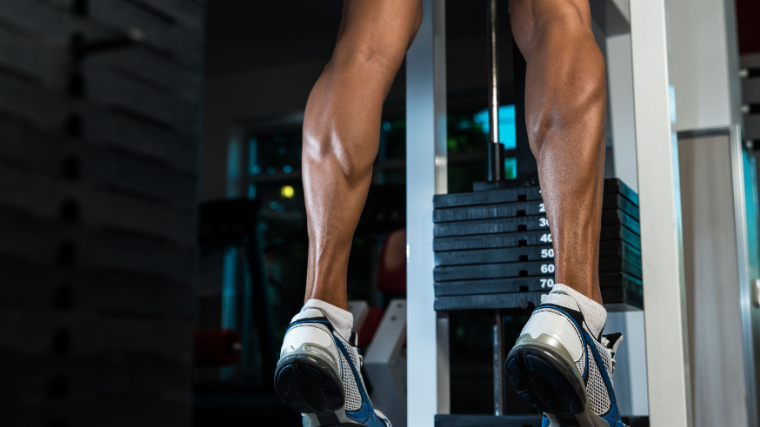Calf workouts can suck. Some regard calve aesthetics and capacity for growth as entirely up to genetics; someone either has them, or they don’t, but that argument won’t fly on the bodybuilding stage — if calves are a physique’s weak point, they must be trained.
A December 2023 study out of the journal Frontiers in Physiology, entitled “Triceps surae muscle hypertrophy is greater after standing versus seated calf-raise training,” had notable findings regarding which calf exercises build the most muscle. Here’s the kicker: The standing calf raise might be the only exercise needed to beef up the calves. There’s some nuance at play, though. Here’s what you need to know:

[Related: The Best Supplements for Bodybuilding in 2024]
What the Study Says
The paper was authored by Kinoshita et al., who set out to assess how to optimally train the calves for muscular hypertrophy. In their work, they argue that “identifying an effective training modality is warranted … because the calves are relatively unresponsive to resistance training.” (1) So, here’s what they did:
Findings
In simpler language, a small group of folks with no strength training experience worked their calves separately for 12 weeks. They performed seated calf raises with one leg and standing calf raises with the other to assess which movement was better for muscle growth. Here’s what happened:
[Related: The Best Bodybuilding Leg Workout You Can Do]
Limitations
Kinoshita and colleagues make some compelling claims in their research throughout this paper, but one single study doesn’t wholly shut the book on calf training. There are a few limitations to this line of research worth considering:
- The study analyzed a small sample of participants. A sample size of 14 is generally not considered large enough to draw broad conclusions.
- By their own admission, the authors did not include a control group to measure against.
- The study discusses that they did not carry out any performance-based analysis, noting that strength and power training may be particularly relevant for the calf musculature.
What You Should Do
This study isn’t the first of its kind. Other exercise science papers have analyzed the efficacy of standing seated calf raises, and many have arrived at similar conclusions. But does that mean the seated calf raise isn’t worth your time? Not necessarily. Still, to put this research into action, you could:
- Try removing seated calf raises from your bodybuilding workout plan for a few months and perform more sets of standing calf raises instead.
- Prioritize a slow eccentric tempo and pauses in the bottom position. The authors of this paper acknowledged that long-length partial reps may be especially valuable for hypertrophy. (2)
- Don’t stress out if you don’t have a seated calf raise machine in your gym. That movement is difficult to replicate with other equipment, but you can do standing calf raises with a Smith machine, barbell, dumbbells, or even your own body weight.
[Related: The Best Pre-Workouts To Buy in 2024]
Key Takeaways
Believe it or not, there is some legitimate scientific basis to the idea that calf size is, at least, partially up to genetics. Studies on androgen receptor density — critical for signaling muscle growth — show that most people have few receptors in their lower limbs compared to the upper body. (3) However, this study does offer some valuable takeaways:
- Researchers compared changes in muscle volume between 14 participants’ legs after they performed standing calf raises with one leg and seated calf raises with the other.
- Overall changes in muscle size were small, but the researchers showed a significant disparity between growth of the two main calf muscles.
- The gastrocnemius, which crosses both the knee and ankle joints, grew much more on average than the soleus, which only affects the ankle.
- This difference may be explained by the fact that there’s some “slack” in the gastroc muscle when the knee is bent. (4)
- The gastrocnemius accounts for a majority of overall triceps surae (calf) volume, and should thus be the priority if training for hypertrophy.
- If you’re struggling to grow your calves and primarily use the seated calf raise variation, you may want to switch to mostly standing calf raises instead.
Are standing calf raises all you need to build muscle? Based on this single study, one could argue so. But as with any bit of scientific research, your best bet is to carefully analyze the data and make an informed decision regarding how it does (or doesn’t) apply to your goals.
More Research Content
- A New Study Reveals 2 Training Techniques to Maximize Muscle Growth
- New Study Suggests Overhead Triceps Extensions Build More Muscle Than Pushdowns
- These Researchers Reveal the Right Way to Train for More Muscle Mass
References
- Kinoshita M, Maeo S, Kobayashi Y, Eihara Y, Ono M, Sato M, Sugiyama T, Kanehisa H, Isaka T. Triceps surae muscle hypertrophy is greater after standing versus seated calf-raise training. Front Physiol. 2023 Dec 13;14:1272106. doi: 10.3389/fphys.2023.1272106. PMID: 38156065; PMCID: PMC10753835.
- Kooistra, R. D., de Ruiter, C. J., & de Haan, A. (2008). Knee angle-dependent oxygen consumption of human quadriceps muscles during maximal voluntary and electrically evoked contractions. European journal of applied physiology, 102(2), 233–242.
- Kadi, F., Bonnerud, P., Eriksson, A., & Thornell, L. E. (2000). The expression of androgen receptors in human neck and limb muscles: effects of training and self-administration of androgenic-anabolic steroids. Histochemistry and cell biology, 113(1), 25–29.
- Hébert-Losier, K., Schneiders, A. G., García, J. A., Sullivan, S. J., & Simoneau, G. G. (2012). Influence of knee flexion angle and age on triceps surae muscle activity during heel raises. Journal of strength and conditioning research, 26(11), 3124–3133.
Featured Image: Jasminko Ibrakovic / Shutterstock
The post New Study: Standing Calf Raises Grow More Than Twice as Much Muscle as Seated appeared first on BarBend.

